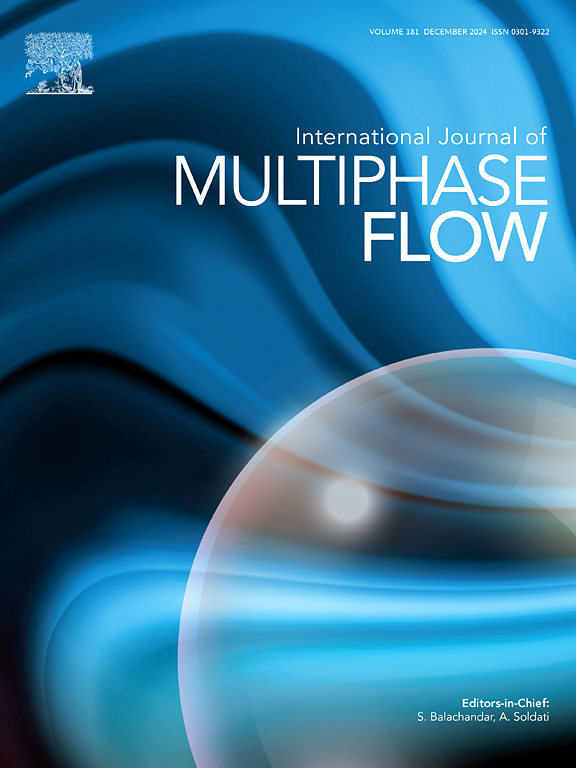Experimental investigation of coherent structures and acoustic properties of a steam jet condensation in crossflow using proper orthogonal decomposition
IF 3.6
2区 工程技术
Q1 MECHANICS
International Journal of Multiphase Flow
Pub Date : 2025-01-22
DOI:10.1016/j.ijmultiphaseflow.2025.105146
引用次数: 0
Abstract
Direct contact condensation of steam jets in crossflow is crucial for various industrial applications, yet its flow structures and noise mechanisms remain inadequately understood. This study investigated the formation and evolution of multi-scale vortex structures in the turbulent jet flow field, which induce significant sound pressure oscillations and pipe vibrations. Multi-scale coherent structures in typical condensation regimes were extracted via high-speed imaging and proper orthogonal decomposition method. Additionally, acoustic and vibration characteristics were characterized by hydrophones and accelerometers, combining with time-domain and frequency-domain analyses. The intensities of sound pressure oscillation and pipe vibrations, which are highly correlated with the condensation regimes, initially rise before declining with increasing steam mass flux, and steadily rise with subcooled water temperature. Notably, the spectral distributions of sound pressure and vibrations shift toward higher frequencies as steam mass flux increases. In unstable regimes, large-scale coherent structures in low-order, high-energy modes dominate sound pressure oscillations. Conversely, in the Stable regime, sound pressure oscillations are influenced by the interaction between fine-scale vortex structures in high-order modes and shear-layer vortices generated by shear-layer instabilities in low-order modes. These findings enhance our understanding of the coherent structures in the turbulent jet flow field and provide insights for identifying noise sources.

用正交正交分解法研究蒸汽射流在横流中凝聚的相干结构和声学特性
蒸汽射流在横流中的直接接触冷凝在各种工业应用中是至关重要的,但其流动结构和噪声机制仍未得到充分的了解。本文研究了湍流射流流场中多尺度涡结构的形成和演化过程,这些涡结构会引起显著的声压振荡和管道振动。通过高速成像和适当的正交分解方法提取了典型缩合状态下的多尺度相干结构。此外,结合时域和频域分析,通过水听器和加速度计对声学和振动特性进行了表征。声压振荡强度和管道振动强度随蒸汽质量流量的增加先上升后下降,随过冷水温度的升高而稳定上升,与冷凝工况密切相关。值得注意的是,随着蒸汽质量通量的增加,声压和振动的频谱分布向更高的频率移动。在不稳定状态下,低阶高能量模态的大尺度相干结构主导声压振荡。相反,在稳定状态下,声压振荡受到高阶模态的精细尺度涡结构和低阶模态剪切层不稳定产生的剪切层涡的相互作用的影响。这些发现增强了我们对湍流射流场中相干结构的理解,并为识别噪声源提供了见解。
本文章由计算机程序翻译,如有差异,请以英文原文为准。
求助全文
约1分钟内获得全文
求助全文
来源期刊
CiteScore
7.30
自引率
10.50%
发文量
244
审稿时长
4 months
期刊介绍:
The International Journal of Multiphase Flow publishes analytical, numerical and experimental articles of lasting interest. The scope of the journal includes all aspects of mass, momentum and energy exchange phenomena among different phases such as occur in disperse flows, gas–liquid and liquid–liquid flows, flows in porous media, boiling, granular flows and others.
The journal publishes full papers, brief communications and conference announcements.

 求助内容:
求助内容: 应助结果提醒方式:
应助结果提醒方式:


